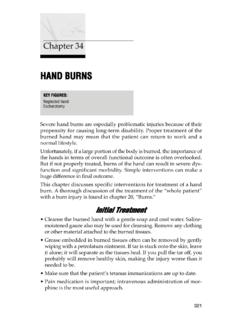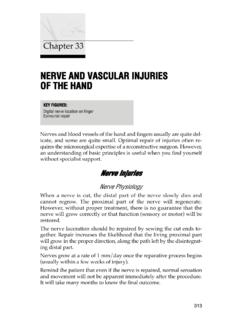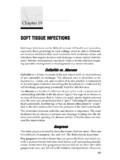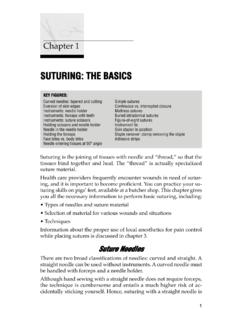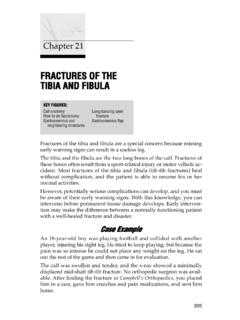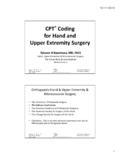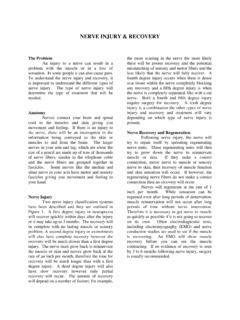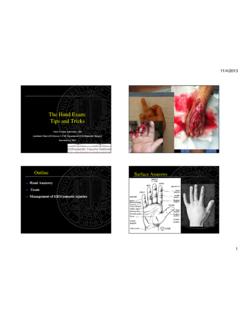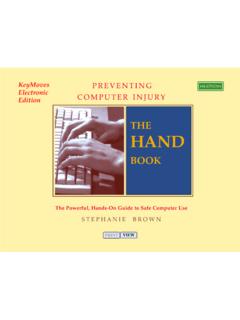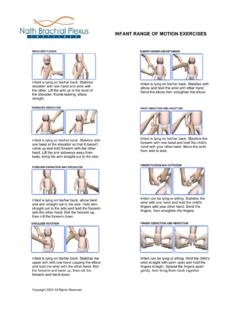Transcription of FINGER FRACTURES AND DISLOCATIONS - Practical Plastic …
1 FFIINNGGEERR FFRRAACCTTUURREESS AANNDD DDIISSLLOOCCAATTIIOONNSSB ecause we use our hands for so many things, FINGER FRACTURES and dislo-cations are common injuries. Unless they are associated with significantsoft tissue injury, definitive treatment is not emergent. Often the initialevaluation and necessary splinting can be done by a nonspecialist. This chapter describes basic treatments for FINGER FRACTURES and disloca-tions that can be done by all health care providers. For the best possibleoutcome, however, more highly technical procedures may be possible, patients with all but the simplest injuries shouldbe referred to a hand specialist for definitive treatment.
2 An occupational therapist also should be consulted to help with reha-bilitation once the fracture or dislocation has been properly areas where specialists are not available, the basic interventions dis-cussed in this chapter can help the patient attain an acceptable func-tional outcome. DDeeffiinniittiioonnssTo reducea fracture or dislocation means to restore the proper anatomicand functional alignment of the bone or joint. For most hand injuries,functional status is most important to the openfracture or dislocation implies a wound in the soft tissuesoverlying the bone injury.
3 In a closedinjury the surrounding skin isintact. This distinction is important. An open fracture or dislocationhas a high risk for infection. To prevent this complication, careful andthorough wash-out of the wound is required. The patient also shouldbe given antibiotics (the oral route is usually sufficient, but extent ofinjury is the determining factor) for at least 48 hours after the repair. A293 Chapter 30 KKEEYY FFIIGGUURREESS::Rotational deformityBuddy tapingReduction of metacarpal fracture294 Practical Plastic surgery for Nonsurgeonsclosed fracture or dislocation is not associated with a high risk of infec-tion; thus, the patient does not require treatment with FFrraaccttuurreessCompared with leg FRACTURES , FINGER FRACTURES may seem to be insignifi-cant injuries.
4 However, FINGER FRACTURES can be quite proper treatment, a FINGER fracture can lead to significant limi-tation in hand function and a digital block before attempting to reduce a fracture . Use acombination of lidocaine and bupivacaine whenever possible to helpwith postprocedure pain Phalangeal FracturesThe distal phalanx is the most commonly fractured bone of the phalangeal FRACTURES are classified into three types: tuft FRACTURES ,shaft FRACTURES , and intraarticular FracturesA tuft fracture involves the most distal portion of the bone.
5 It usually iscaused by a crush mechanism, such as hitting the tip of the FINGER witha hammer. A tuft fracture is often an open fracture because of itscommon association with injury to the surrounding soft tissues and/ornail bed. Even without injury to surrounding soft tissue, the fracture isconsidered open in the presence of nail bed The soft tissue wound should be cleansed thoroughly, and all for-eign material should be In patients with a subungual hematoma > 50% of the nail surface,consider removing the nail to allow repair of the nail bed (see chap-ter 29, Fingertip and Nail Bed Injuries ).
6 3. Soft tissues should be sutured loosely in an interrupted fashion. Use4-0 nylon or chromic material. Repair the nail bed with 5-0 or 6-0chromic sutures. Repair of soft tissues usually leads to adequate re-duction of the Cover the suture line with antibiotic ointment and dry gauze. Thedressing should be changed Keep the FINGER elevated as much as FRACTURES and DISLOCATIONS 2956. Strongly advise the patient to avoid smoking. Tobacco productsslow the healing Provide pain medication. Tuft FRACTURES are often quite painful andtender for several The patient may wear a protective splint or bulky dressing over thefingertip and distal interphalangeal (DIP) joint to prevent move-ment.
7 The splint also protects the FINGER from accidental , do notimmobilize the entire FINGER with the dressing orsplint. Complete immoblization leads to unnecessary FINGER Once the FINGER is less tender (usually within 10 14 days), encour-age the patient to gradually resume normal use of the FracturesShaft FRACTURES involve the central portion of the distal phalanx. Theyalso are associated often with soft tissue or nail bed injuries. As de-scribed above, repair of any soft tissue usually leads to adequate re-duction of the further bone stabilization, a 20-gauge needle can be passed manu-ally from the end of the fingertip into the bone segments.
8 This procedureshould be done before repair of any soft tissue injury (if present). Theneedle easily passes through the soft tissues into the bone if it is pushedfirmly with a twisting motion. Bend the top part of the needle (the hub)so that it does not protrude too far from the end of the , shaft FRACTURES are treated like tuft FRACTURES . If a needle is usedto stabilize the fracture , remove it when the fingertip is no longer FracturesIntraarticular FRACTURES involve the joint surface of the distal phalanx atthe DIP joint.
9 The patient may present with a mallet deformity (inabil-ity to extend the DIP joint fully) if the fracture involves the bony inser-tion of the extensor tendon. In this setting, treat the FINGER like a malletfinger, as described in chapter 32, Tendon Injuries of the Hand. If there is no evidence of mallet deformity, the joint surface should bealigned as meticulously as possible to ensure optimal function. Such in-juries are best referred to a hand specialist. If no specialist is available:1. Manipulate the FINGER to align the bone pieces as precisely as possible.
10 2. Immobilize the DIP joint in 0 10 of flexion for 10 14 days. You canuse a plaster splint or make a splint from a tongue depressor. Alter-natively, the 20-gauge needle technique (described above) can beused to immobilize the DIP Practical Plastic surgery for Nonsurgeons3. However you immobilize the joint, be sure to allow motion of theproximal interphalangeal (PIP) joint. 4. When the FINGER is no longer tender, the patient should start movingthe joint both passively and actively in hope of regaining functionalrange of motion at the DIP and Proximal Phalangeal FracturesMiddle and proximal phalangeal FRACTURES are classified according towhether they involve the joint FracturesExtraarticular FRACTURES affect the part of the bone that is not involvedwith the joint surface.
